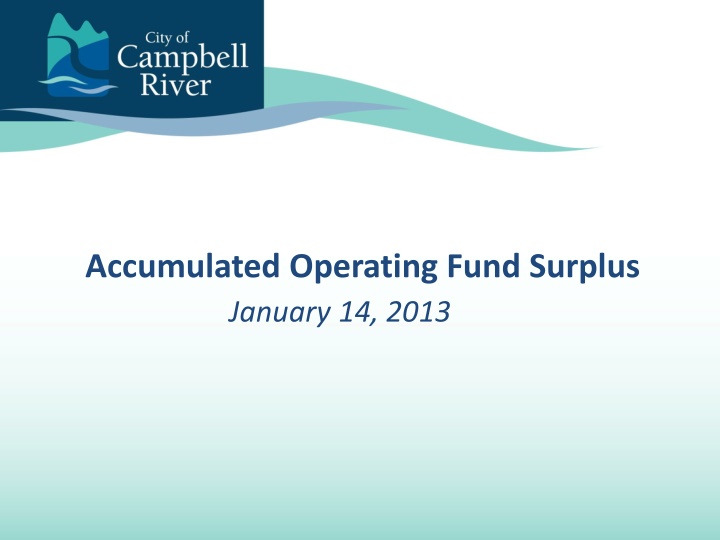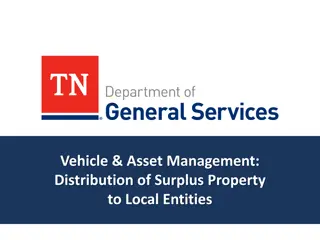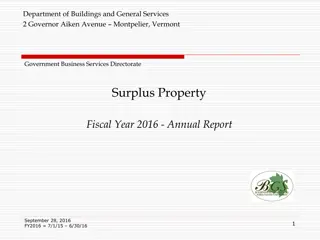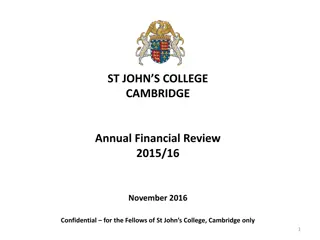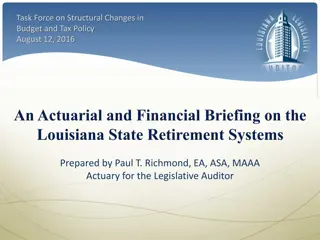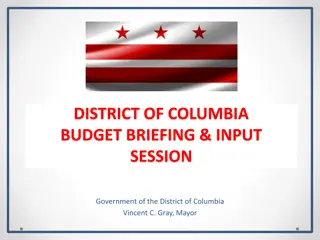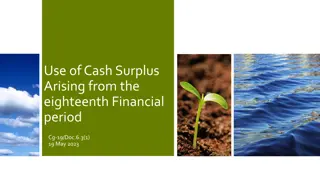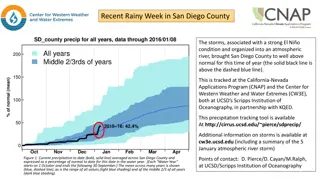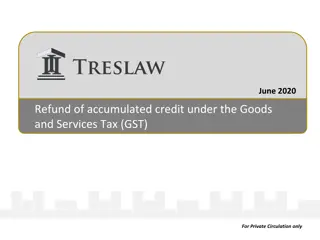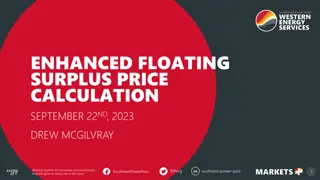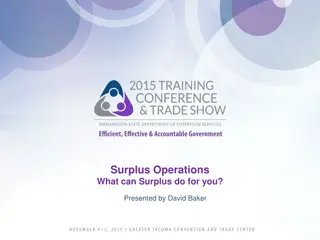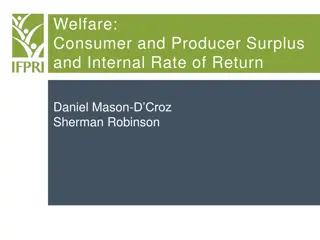Financial Policy Recommendations for Accumulated Surplus Management
The council policy recommends retaining an accumulated surplus up to 4% of operating expenditures, with any excess transferred to the Capital Works Reserve. The rationale behind this policy includes ensuring cash flow, setting aside funds for future expenditures, maintaining a rainy day fund, and providing a reserve for unforeseen financial challenges. The policy aims to eliminate the need for short-term borrowing and address future capital shortfalls, ensuring financial sustainability.
Download Presentation

Please find below an Image/Link to download the presentation.
The content on the website is provided AS IS for your information and personal use only. It may not be sold, licensed, or shared on other websites without obtaining consent from the author.If you encounter any issues during the download, it is possible that the publisher has removed the file from their server.
You are allowed to download the files provided on this website for personal or commercial use, subject to the condition that they are used lawfully. All files are the property of their respective owners.
The content on the website is provided AS IS for your information and personal use only. It may not be sold, licensed, or shared on other websites without obtaining consent from the author.
E N D
Presentation Transcript
Accumulated Operating Fund Surplus January 14, 2013
Recommendations THAT Council confirm its existing policy to retain Accumulated Surplus (up to 4% of operating expenditures). THAT Council authorize the annual transfer of accumulated surplus exceeding Council s policy to the Capital Works Reserve to help address future projected capital shortfalls. 2
Background Accumulated Surplus: Consists of Annual Surpluses, accumulated over the years. Is reported in the Audited Financial Statements annually: 2010 2011 2012 Accumulated Surplus $4.369 M $4.893 M $4.752 M For 2013, a modest Annual Surplus is expected, increasing Accumulated Surplus marginally. 3
Current Council Policy In 2001, Council confirmed their policy pertaining to Accumulated Surplus: A minimum General Revenue Fund surplus retention of 4.0% of total annual expenditures based on the average of the last three years actual expenses is established . Current Accumulated Surplus balance $4.746 million Preliminary estimates on minimum required balance for 2014 is $3.895 million Identifies $851,000 excess recommended for Capital Works Reserve 4
Rationale for Current Council Policy There are 4 reasons why the 4% retention policy can be considered a sound, sustainable financial practice: 1. Provides cash flow 2. Sets aside funds for anticipated future expenditures 3. Maintains a rainy day fund for unanticipated emergency expenditures 4. Provides a reserve for budget miscalculations or unforeseen drops in revenues 5
Cash Flow Tax and User Fee collections occur in July of each year Total levy is approximately $34 Million Require $17 Million in the bank to cover operating expenses from Jan-Jul each year Current reserve levels are projected to shrink below $17M over the course of the 5-year plan Retention of Accumulated Surplus critical to eliminate need for short-term borrowing to sustain operations. 6
Anticipated Future Expenditures $8 Million annual amortization on Tangible Capital Assets This amortization expense is currently unfunded Tangible Capital Assets continue to age with little provision currently being made to address future capital shortfall Recommendation to place any excess Accumulated Surplus above the 4% retention into the Capital Works Reserve to address this shortfall 7
Emergency & Rainy Day Funds Emergency situations are unplanned but can have major financial implications Unusual weather events Earthquake Police incidents Accumulated Surplus acts as a contingency for such unplanned expenditures Rainy day funds can be used for emergent strategic priorities Downtown Revitalization Emergent land acquisitions 8
Budget Miscalculations Budget consists of many assumptions & estimates Sometimes errors occur 2013 Yard Waste budget error This error was corrected through use of Annual Surplus (due to other department underages) and not Accumulated Surplus Staff do not use Accumulated Surplus to balance or offset unbudgeted costs without Council approval Accumulated Surplus provides a cushion to offset any such errors should they be beyond the amount that can be absorbed within any Annual Surplus (budget amendment would be required) 9
Use of Accumulated Surplus for One-Time Tax Relief Any transfers from Accumulated Surplus for ongoing items (including lowering taxes) must continue every year thereafter to prevent a larger tax increase in each year 2013 25,000,000 2014 25,000,000 Increase 2015 Increase Operating Budget 25,417,000 Current Yr. Increase 417,000 417,000 Total Op. Budget 25,000,000 25,417,000 2.25% 25,834,000 4.5% Use of Acc. Surplus (417,000) (2.25%) 0 0% Required Tax Levy 25,000,000 0.00% 25,834,000 4.5% 1 0
Legislation No governing legislation specific to Accumulated Surplus City s revenues and expenditures must be balanced Debt may be incurred only under specific circumstances City must comply with PSAB reporting principles TCA & Amortization 11
Other Municipalities District of Mission Reserve and Surplus policy recognized by GFOABC as Best Practices Mission s Accumulated Surplus retention policy is based on minimum & optimum thresholds: Accumulated Surplus - 1 to 2 month operating expenditures Financial Stabilization 1 to 2.5% operating revenues Using Mission s policy, City s Accumulated Surplus is above minimum but below optimum levels Op Op Expenses (2013) Revenues (2013) Minimum Optimum Accumulated Surplus Stabilization Reserve Total $33,229,000 $2,769,000 $5,538,000 $19,958,000 $200,000 $499,000 $2,969,000 $6,037,000 12
Accumulated Surplus Use in Past Three Years Activity per Appendix A of Council Report: Annual Surplus of each fiscal year accumulates Budget Carryforward items Reserve transfers Accumulated Surplus not used to balance budget without Council approval Unbudgeted items require budget amendment unless absorbed by current year Annual Surplus 13
Questions? 14
